

I didn’t know a hybrid sedan could take a corner that fast. We were sitting in the car, adjacent to the runway where NASA’s ER-2 high-altitude aircraft was about to land. Tim Williams – an ER-2 pilot who will fly later this campaign – was driving, poised to speed down the runway after the plane, in case his fellow pilot needed help avoiding obstacles and gauging conditions.
And as soon as the sleek ER-2 came into view and descended over the runway, we were off. Williams hit the gas (battery?) on the hybrid and swung onto the runway, sending me and my video camera flailing against the passenger-side door as the aircraft buzzed overhead. We raced down the runway, chasing after the plane as it landed, balanced on its two wheels.
On board the ER-2 is MABEL – the Multiple Altimeter Beam Experimental Lidar – a laser altimeter that is gathering data for the ICESat-2 mission. Wednesday’s flight was the first science flight of MABEL’s summer campaign to measure summer sea ice, land ice and more in Alaska.
The day started with a crew and weather briefing at 7 a.m., where pilots Denis Steele and Williams reviewed weather conditions and possible routes with ER-2 Mission Manager Tim Moes, NASA Goddard scientists Thorsten Markus and Kelly Brunt, weather forecasters and others.
With cloudy conditions on the way to the North Pole – covering the dynamic melting edge of the sea ice the campaign hopes to document – the team decided to head southeast out of Fairbanks. That route heads down to the Alaska Peninsula to survey volcanoes, then heads east over glaciers and high-elevation ice fields in south central to southeastern Alaska.
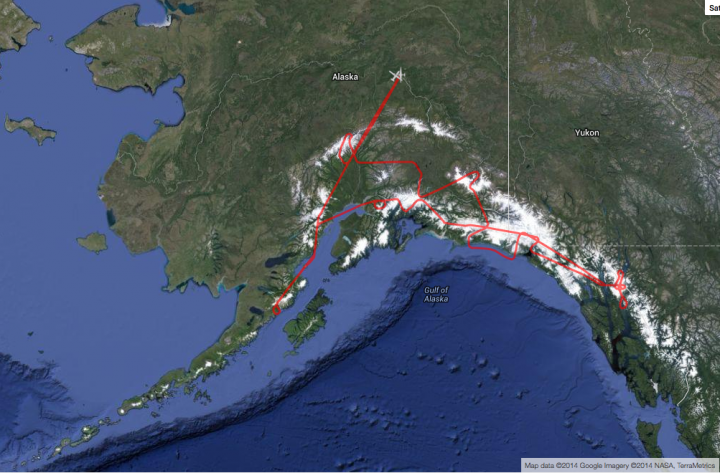
The ER-2, with MABEL on board, flew over volcanoes and glaciers in south central and southeastern Alaska. (http://airbornescience.nasa.gov/tracker/)
With the flight route set, scientists made final checks of the instruments and Steele put on a pressurized suit – necessary for flying at 65,000 feet. He has to “pre-breathe” pure oxygen for an hour before flight, to raise his blood oxygen level.
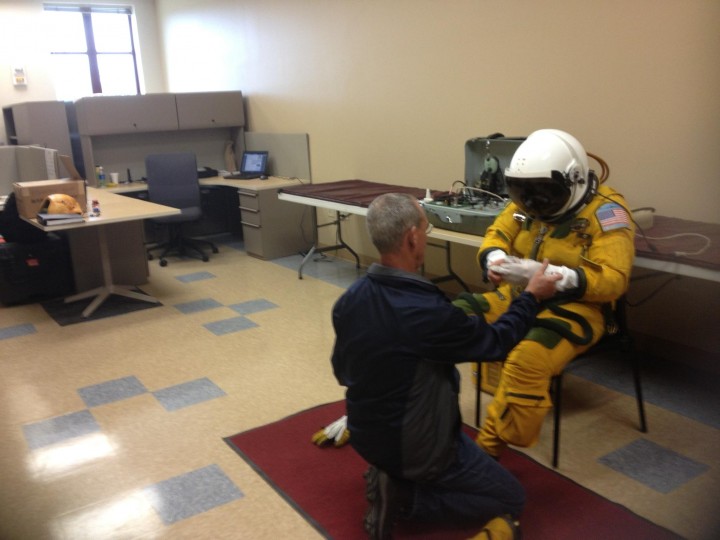
Ryan Ragsdale, engineering technician, helps ER-2 pilot Denis Steele put on a pressurized suit before the flight, which will take him to 65,000 feet. (Credit: Valerie Casasanto/NASA)
Meanwhile, the plane was slowly towed out of the hangar onto the runway at Fort Wainwright and fueled up. The ER-2 crew and Williams went through the preflight checklist, which would be difficult for Steele as the pressurized suit has big gloves and limited dexterity.

ER-2s Denis Steele, in the cockpit, and Tim Williams, checking notes, get ready for the day’s flight. (Credit: Kate Ramsayer/NASA)
After Steele got in and started the engines, he taxied to the end of the runway accompanied by a maintenance van and a chase car: the van so that the crew could grab the bright orange stabilizing wheels, which fall off during takeoff, and the chase car driven by Williams, who supports Steele as necessary.
The ER-2 takes off amazingly fast. One moment it’s at the end of the runway, the next, the roar of the engine sounds. Then, all of a sudden, the aircraft’s in the air, climbing fast to the clouds. The plane disappeared into the clouds before the sound faded, and then the team went back to check the instruments’ vital signs, transmitted from flight.
Just under seven hours later, after flying over a number of key glacier and volcano points north of the Gulf of Alaska, Steele landed the plane. The crew reattached the bright orange stabilizing wheels, and towed him back to the hangar, where scientists were eager to download and view the data.
Steele reported on highlights of the flight – what was cloudy, what was clear – and Moes ended with a reminder of the next early morning meeting to review weather conditions and determine whether the ER-2 would fly another route over Alaska today.
Clouds blanketed much of MABEL’s potential flight routes over the Alaskan Arctic or southern glaciers on Monday, so the ER-2 aircraft stayed in the hangar at Fort Wainwright in Fairbanks, Alaska.
But the MABEL team was busy. They took advantage of a day on the ground by improving the instrument’s new camera. The goal is to take more images like the one below, to help scientists interpret the data from the airborne lidar instrument.
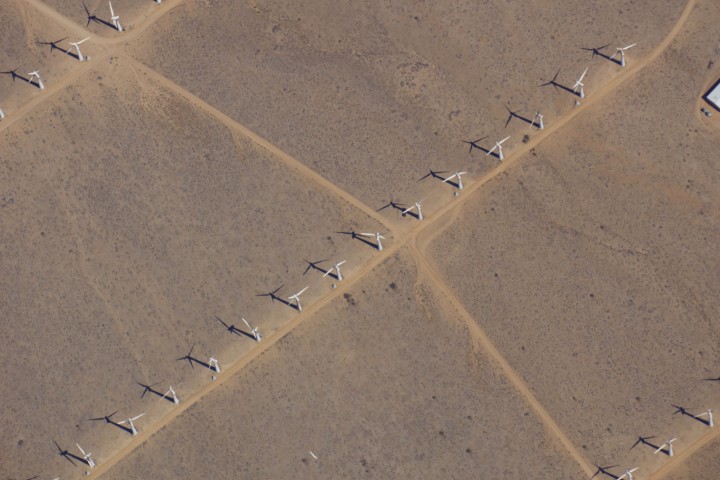
As the ER-2 aircraft traveled from Palmdale, California, to Fairbanks, Alaska, the camera on MABEL took this shot of wind turbines near Bakersfield, California. (Credit: NASA)
It’s the first week of the summer 2014 campaign for MABEL, or the Multiple Altimeter Beam Experimental Lidar, the ICESat-2 satellite’s airborne test instrument. MABEL measures the height of Earth below using lasers and photon-counting devices. This year, the team is using a new camera system to take snapshots of the land, ice and water in parallel with MABEL’s measurements.
The MABEL instrument is nestled snug in the nose cone of the high-altitude ER-2, which has a circular window in the base where the laser and the camera view the ground. To get access to MABEL and the camera, the crew propped up the nose and wheeled it away from the aircraft.

The ER-2 crew rolls the aircraft’s nose — containing MABEL — away from its body, so engineers could work on the instrument. (Credit: Kate Ramsayer/NASA)
The team then carefully slid the instrument out onto a cart, so that MABEL’s on-site engineer and programmer – Eugenia DeMarco and Dan Reed – could work on the camera and ensure the connections were sound.
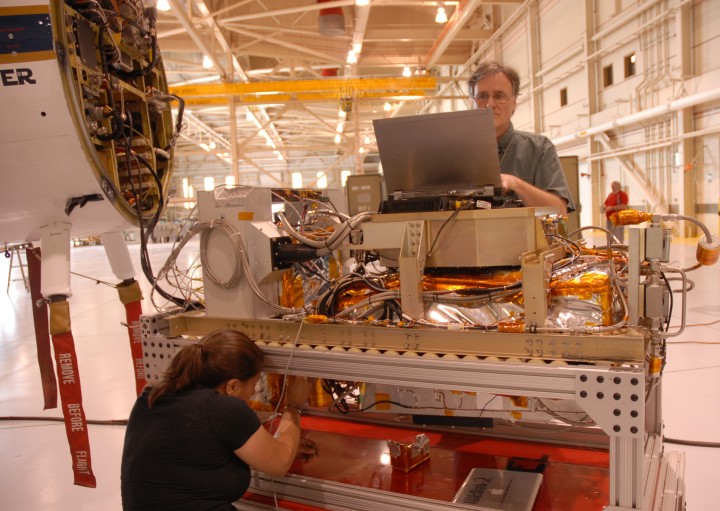
MABEL engineer Eugenia DeMarco and programmer Dan Reed work on improving the new camera system for the instrument. (Credit: Kate Ramsayer/NASA)
When the camera was set to document the terrain from 65,000 feet, the team slid MABEL back to its spot and wheeled the aircraft’s nose back to the rest of its body. They connected the instrument to the plane’s electronics, sealed the plane back up, and are ready to go whenever the weather cooperates.

Luis Rios, with NASA’s ER-2 crew, checks the connections between the MABEL instrument and the aircraft. (Credit: Kate Ramsayer/NASA)
From early July through mid-August 2014, scientist Doug Morton of NASA’s Goddard Space Flight Center in Greenbelt, Maryland, will be flying low over the treetops of interior Alaska. The purpose? First-of-a-kind look at the state’s forests with a portable, airborne imaging system called G-LiHT to map the composition, structure and function of the ecosystem.
According to Morton, key components of the fieldwork include:
“First, we are partnering with the U.S. Forest Service, as directed by the recently-passed Farm Bill, to incorporate remote sensing technology into forest monitoring efforts. Our pilot study will be the first inventory of forests in interior Alaska; a standard ground inventory (as in the lower 48) has always been too costly or logistically challenging to implement.
Second, we will study post-fire recovery, with plans to sample more than 80 percent of all fires in the Tanana region since 1950. Fire is the major agent of change in interior Alaska, and understanding the patterns of forest recovery is essential to gauge the vulnerability/resilience of forests to future climate change.
Third, we will benchmark conditions (topography/permafrost, forest cover, forest composition) across a large portion of the Arctic-Boreal Vulnerability Experiment (ABoVE) science domain.”
Follow Morton through the summer as, Internet connection permitting, he sends updates and photos from the field.
Very few people get to fly 65,000 feet above Alaska’s glaciers. And even fewer get to fly over ones they share a name with. But on Friday, as pilot Denis Steele flew NASA’s ER-2 aircraft from Palmdale, California, to Fairbanks, Alaska, he snapped a picture of the scenery below – including Steele Glacier in the southwestern corner of Canada’s Yukon territory.
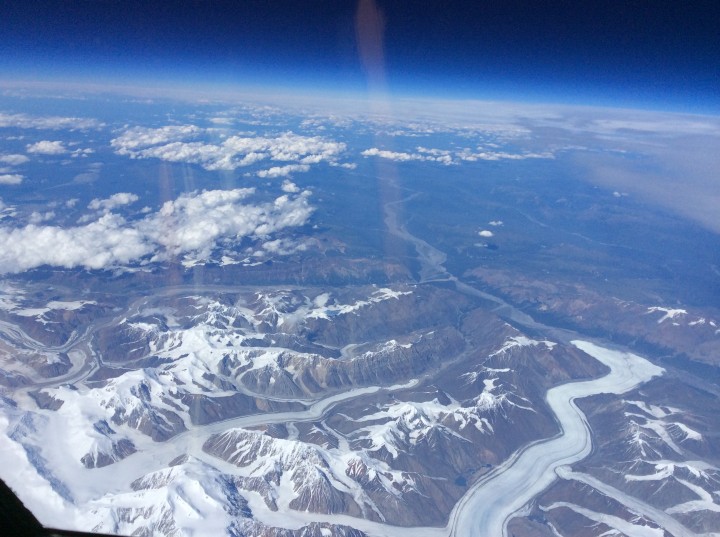
From NASA’s ER-2 aircraft, pilot Denis Steele saw glaciers in southern Alaska and Canada — including the Steele Glacier, the horizontal feature in the center of the image, and the Donjek Glacier (lower right). (Credit: Denis Steele)
Steele and the ER-2 team, along with NASA scientists, engineers and others, are here in Fairbanks to fly a laser altimeter – MABEL, or Multiple Altimeter Beam Experimental Lidar – over melting summer sea ice, glaciers and more. It’s a campaign to see what these polar regions will look like with data from ICESat-2, once the satellite launches and starts collecting data about the height of Earth below. Gathering information now allows scientists to get a head start in developing the computer programs scientists will need to analyze ICESat-2’s raw data.
MABEL and other lidar instruments are flying on the ER-2, which provides a high-altitude perspective. In the next three weeks, the plan is to cover melting sea ice, glaciers, vegetation, lakes, and more.
Steele wasn’t the only one looking out of the plane windows on flights north. Kelly Brunt, a research scientist at NASA’s Goddard Space Flight Center, spotted a wildfire in Eastern Washington. The fire, burning in steep terrain, resembled an erupting volcano.
Over the weekend, the team settled into Fairbanks and a hangar at the U.S. Army’s Fort Wainwright, downloading data from the transit flight and ensuring the instruments are ready to fly when the weather allows. Cloudy skies over key sites means the ER-2 won’t fly today (Monday), but the team will check the weather tonight and see if it clears enough to fly the first science flight on Tuesday.
Want to follow MABEL and the ER-2? Check back here, and also check NASA’s flight tracker: http://airbornescience.nasa.gov/tracker/